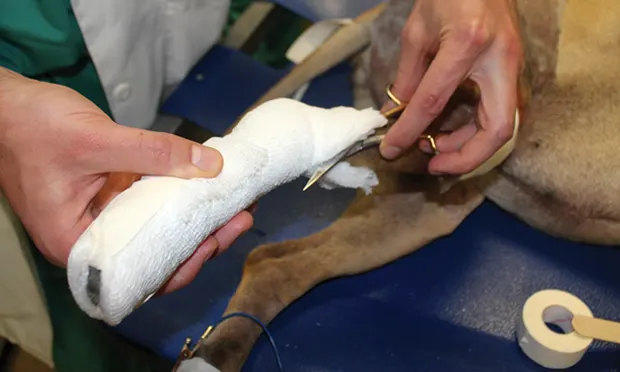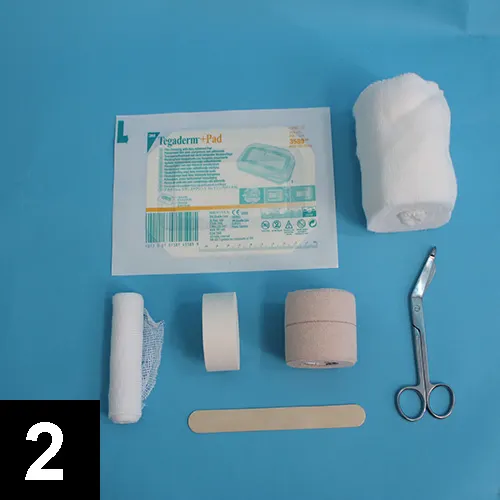The 90-90 Flexion Bandage

Quadriceps contracture (ie, quadriceps tie-down) can be a devastating sequela to stabilization of femoral fractures. It is a severe manifestation of fracture disease that occurs most frequently in skeletally immature dogs and cats that sustain physeal or other fractures involving the distal femur. In cases of quadriceps contracture, the involved pelvic limb becomes permanently fixed in rigid extension, impeding ambulation (Figure 1). Some cases of quadriceps contracture are unavoidable, such as those resulting from vascular compromise of the quadriceps muscle group sustained during a traumatic incident that caused the fracture. Other cases can be attributed to faulty fracture management.
Related Article: Bandaging & Splinting Canine Elbow Wounds

Figure 1. With quadriceps contracture, the involved pelvic limb becomes permanently fixed in rigid extension.
Previous Methods & ApplicationPreviously, distal femoral fractures were frequently managed in a closed fashion by placing the limb in coaptation, which positioned the stifle and hock joints in extension, predisposing the patient to develop quadriceps contracture. With advancement in orthopedics, open anatomic reduction and stable fixation became standard for most femoral fractures; however, some patients still developed quadriceps contracture even when appropriate surgical techniques were applied. Many animals maintain the repaired pelvic limb in extension after anesthesia and appear painful and uncooperative when manual flexion of the affected stifle and hock is attempted.
Related Article: A Novel Bandaging Method
A Different ApproachAron and Crowe described application of the 90-90 flexion bandage, which maintains the stifle and hock joints in 90° of flexion to decrease the occurrence of quadriceps contracture following open stabilization of femoral fractures.1 Prolonged coaptation is contraindicated following open fracture reduction, as a splint or bandage provides no appreciable mechanical stability to internal implants placed during surgery, and prolonged immobilization of involved limb segments promotes development of fracture disease. The 90-90 flexion bandage maintains the quadriceps muscle group in an extended position transiently during the early postoperative convalescent period.
As originally described, the 90-90 flexion bandage was maintained for a mean of 11 days (range, 7–21 days)1; however, the author has found maintaining the splint for 48 to 72 hours to be sufficient. After bandage removal, most patients begin placing weight on the affected limb, can maintain the affected stifle positioned in a normal standing angle (ie, 135°), and are amenable to manual flexion of the involved stifle.
Related Article: Wound Management: Tie-Over Bandages

What You Will Need
Bandage scissors
Nonadherent adhesive bandage (Tegaderm+Pad, 3m.com)
Tongue depressor
Roll of porous white adhesive tape (Zonas, jnj.com)
1–2 rolls of cast padding (multiple brands, bsnmedical.com)
1–2 rolls of stretch bandage (Curity, covidien.com)
1–2 rolls of adhesive elastic tape (Elastikon, jnj.com)
DANIEL D. LEWIS, DVM, DACVS, is Jerry & Lola Collins Eminent Scholar in Canine Sports Medicine and Comparative Orthopaedics and professor of small animal surgery at University of Florida. Dr. Lewis is former president of the Veterinary Orthopedic Society and recipient of the WSAVA Hill’s Pet Mobility Award. His interests include musculoskeletal traumatology, fracture management, and reconstructive orthopedic surgery. Dr. Lewis earned his DVM from University of California, Davis and served as surgical registrar at Sydney University and assistant professor at Louisiana State University.